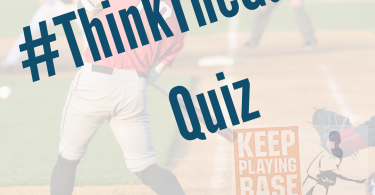The Situation:
There are 2 outs in the top of the 6th inning of a 4-3 ballgame. The first two outs of the inning come quick and the defense is looking to get back in the dugout and add to their lead. That’s where the trouble starts. The pitcher falls behind the 3rd hitter of the inning 3-0 with 3 non-competitive pitches. Then he throws a borderline fastball on the outside corner that is called a ball for a free pass. The pitcher is not happy with the call. The next hitter comes up and again the pitcher falls behind 1-0.
The Play:
On the 1-0 pitch, the pitcher lays a fastball down the middle at the knees. The left handed hitter swings and hits a hard, top-spin ball towards the first baseman, who is coming off the bag after holding the runner. The first baseman can’t seem to play the ball into a good hop. He tries to field the ball off of the tough second hop, but the ball takes off on the hard, dry ground. In an awkward display, he waves at the ball. It tips off the top of the fingers of his glove and continues down the right field line towards the corner. With the field playing hot in the warm weather, the ball just keeps going.
The Outcome:
By the time the right fielder has tracked down the ball, the batter is standing at second with a double and the runner from first has come all the way around to score without so much as a throw to the plate. The lead is gone, and so is the pitcher’s composure. As the pitcher gathers the ball from his second baseman, he sees the “H” flash up on the scoreboard indicating a hit and an earned run. He looks at the first baseman in disgust with his hands on his hips. They both know it’s a play that should be made.
What Went Wrong:
There are a number of problems in this play, so let’s just list them.
- The pitcher gets two quick outs, then falls behind and walks the batter in an non-competitive at bat.
- The pitcher falls behind the 4th hitter of the inning, setting up a fastball count and increasing the chances that the ball is hit hard (which it is).
- The first baseman can’t play himself into an easy hop. This can either be looked at as a mistake, or not. Sometimes as a fielder, you just don’t have time to create a predictable hop. Hard hit top-spin grounders to the corner infielders can be this type of play, especially when the first baseman has to hold a runner on and is slow getting off the bag.
- The pitcher shows up his teammate and transfers the blame of his poor performance in mistakes 1 and 2.
We’ve talked about hard choppers to first base before, and that think the game is worth a read. The mistakes we want to focus on here, however, are numbers 1, 2, and 4. First, it is a Cardinal Sin of pitching to walk a hitter after 2 quick outs, especially on 4 straight balls. This is pretty common knowledge. We also know that when you fall behind a batter and have to groove a fastball, bad things happen. In retrospect, the pitcher will realize that he manufactured this run for the offense. While the first baseman could have and arguably should have bailed him out, to blame the run on him is a classic case of transfer of blame. As we have noted before, transfer of blame is an unacceptable form of excuse making that happens when a player deflects responsibility for his failure to accomplish something and blames the outcome on something external or beyond his control. In this case, the pitcher transfers blame onto his teammate.
The reality is that the pitcher is directly responsible for delivering the pitches to the batters. He can’t ensure they are called strikes, but he is responsible for making quality, competitive pitches. That’s what he can control. The big mistake here is providing a non-competitive free pass and falling behind batters. When pitchers are inconsistent in the zone, it makes it harder for everyone to do their jobs. The zone seems to shrink, catchers lose their ability to present pitches favorably, defense gets out of rhythm, and the list goes on. Showing up your teammates and transferring blame are never acceptable, and are two ways to ensure that you and your team do not reach full potential. It’s also something that will get you crossed off a college recruiter’s list in a hurry. Control what you can control, and control your reaction to what you can’t. That’s thinking the game!







